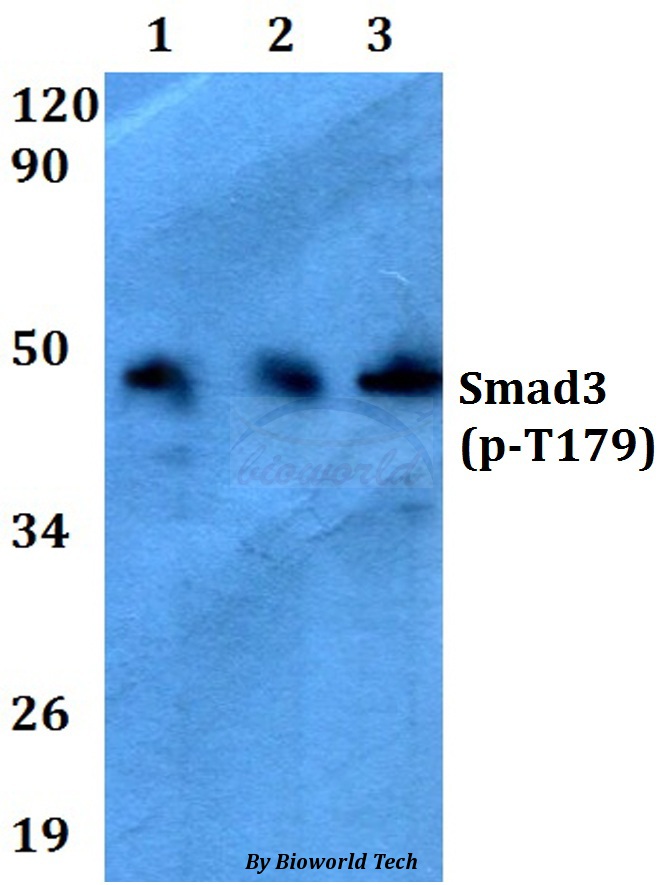Product Name :
Smad3 (phospho-T179) polyclonal antibody Background :
Smad proteins, the mammalian homologs of the Drosophila mothers against decapentaplegic (Mad), have been implicated as downstream effectors of GFβ/BMP signaling. Smad1 (also designated Madr1 or JV4-1) and Smad5 are effectors of BMP-2 and BMP-4 function, while Smad2 (also designated Madr2 or JV18-1) and Smad3 are involved in TGFβ and activin-mediated growth modulation. Smad4 (also designated DPC4) has been shown to mediate all of the above activities through interaction with various Smad family members. Smad6 and Smad7 regulate the response to activin/TGFβ signaling by interfering with TGFβ-mediated phosphorylation of other Smad proteins. Product :
Rabbit IgG, 1mg/ml in PBS with 0.02% sodium azide, 50% glycerol, pH7.2 Storage&Stability :
Store at 4°C short term. Aliquot and store at -20°C long term. Avoid freeze-thaw cycles. Specificity :
p-Smad3 (T179) polyclonal antibody detects endogenous levels of Smad3 protein only when phosphorylated at Thr179. Immunogen :
Synthetic phosphopeptide derived from human Smad3 around the phosphorylation site of Threonine 179. Conjugate :
Unconjugated Modification :
Phosphorylation
Smad3 (phospho-T179) polyclonal antibody Background :
Smad proteins, the mammalian homologs of the Drosophila mothers against decapentaplegic (Mad), have been implicated as downstream effectors of GFβ/BMP signaling. Smad1 (also designated Madr1 or JV4-1) and Smad5 are effectors of BMP-2 and BMP-4 function, while Smad2 (also designated Madr2 or JV18-1) and Smad3 are involved in TGFβ and activin-mediated growth modulation. Smad4 (also designated DPC4) has been shown to mediate all of the above activities through interaction with various Smad family members. Smad6 and Smad7 regulate the response to activin/TGFβ signaling by interfering with TGFβ-mediated phosphorylation of other Smad proteins. Product :
Rabbit IgG, 1mg/ml in PBS with 0.02% sodium azide, 50% glycerol, pH7.2 Storage&Stability :
Store at 4°C short term. Aliquot and store at -20°C long term. Avoid freeze-thaw cycles. Specificity :
p-Smad3 (T179) polyclonal antibody detects endogenous levels of Smad3 protein only when phosphorylated at Thr179. Immunogen :
Synthetic phosphopeptide derived from human Smad3 around the phosphorylation site of Threonine 179. Conjugate :
Unconjugated Modification :
Phosphorylation
-
 Western blot (WB) analysis of p-Smad3 (T179) polyclonal antibody at 1:500 dilution Lane1:HEK293T cell lysate treated with TNFa(20ng/ml,15mins) Lane2:Raw264.7 cell lysate treated with TNFa(20ng/ml,15mins) Lane3:PC12 cell lysate treated with TNFa(20ng/ml,15mins)
Western blot (WB) analysis of p-Smad3 (T179) polyclonal antibody at 1:500 dilution Lane1:HEK293T cell lysate treated with TNFa(20ng/ml,15mins) Lane2:Raw264.7 cell lysate treated with TNFa(20ng/ml,15mins) Lane3:PC12 cell lysate treated with TNFa(20ng/ml,15mins)
Anti‑fibrotic effects of Acremoniumterricola milleretal mycelium on immunological hepatic fibrosis in rats
PMCID: Pubmed No.:25270983
C1q/tumor necrosis factor-related protein-6 attenuates post-infarct cardiac fibrosis by targeting RhoA/MRTF-A pathway and inhibiting myofibroblast differentiation
PMCID: Pubmed No.:25962701
CTRP3 attenuates post-infarct cardiac fibrosis by targeting Smad3 activation and inhibiting myofibroblast differentiation.
PMCID: Pubmed No.:26138247
Oroxylin A inhibits invasion and migration through suppressing ERK/GSK‐3β signaling in snail‐expressing non‐small‐cell lung cancer cells
PMCID: Pubmed No.:26741501
Novel hydrogen sulfide-releasing compound, S-propargyl-cysteine, prevents STZ-induced diabetic nephropathy
PMCID: Pubmed No.:27055593
Anti‑fibrotic effects of Acremoniumterricola milleretal mycelium on immunological hepatic fibrosis in rats
PMCID: Pubmed No.:25270983
Oroxylin A inhibits invasion and migration through suppressing ERK/GSK‐3β signaling in snail‐expressing non‐small‐cell lung cancer cells
PMCID: Pubmed No.:26741501
Novel hydrogen sulfide-releasing compound, S-propargyl-cysteine, prevents STZ-induced diabetic nephropathy
PMCID: Pubmed No.:27055593
CTRP3 attenuates post-infarct cardiac fibrosis by targeting Smad3 activation and inhibiting myofibroblast differentiation
PMCID: Pubmed No.:26138247
Novel hydrogen sulfide-releasing compound, S-propargyl-cysteine, prevents STZ-induced diabetic nephropathy
PMCID: Pubmed No.:27055593
Gambogic acid suppresses cancer invasion and migration by inhibiting TGFβ1-induced epithelial-to-mesenchymal transition
PMCID: Pubmed No.:28404892
The phosphorylation of the Smad2/3 linker region by nemo-like kinase regulates TGF-β signaling
PMCID: Pubmed No.:33676893
Epithelial and interstitial Notch1 activity contributes to the myofibroblastic phenotype and fibrosis
PMCID: Pubmed No.:31718671
CTRP15 derived from cardiac myocytes attenuates TGFβ1-induced fibrotic response in cardiac fibroblasts
PMCID: Pubmed No.:32424654
Fisetin Alleviates Atrial Inflammation, Remodeling, and Vulnerability to Atrial Fibrillation after Myocardial Infarction
PMCID: Pubmed No.:31666455
Bioworld Biotech only provide peptides for our antibodies and do not provide additional peptide customization services.
Price/Size :
USD 368/1mg/vial
Tips:
For phospho antibody, we provide phospho peptide(0.5mg) and non-phospho peptide(0.5mg).Describe :
Blocking peptides are peptides that bind specifically to the target antibody and block antibody binding. These peptide usually contains the epitope recognized by the antibody. Antibodies bound to the blocking peptide no longer bind to the epitope on the target protein. This mechanism is useful when non-specific binding is an issue, for example, in Western blotting (WB) and Immunohistochemistry (IHC). By comparing the staining from the blocked antibody versus the antibody alone, one can see which staining is specific; Specific binding will be absent from the western blot or IHC performed with the neutralized antibody.Formula:
Synthetic peptide was lyophilized with 100% acetonitrile and is supplied as a powder. Reconstitute with 0.1 ml DI water for a final concentration of 10 mg/ml.The purity is >90%,tested by HPLC and MS.
Storage:
The freeze-dried powder is more stable. For short time at 2-8°C. For long term storage store at -20°C.
Note :
This product is for research use only (RUO only). Not for use in diagnostic or therapeutic procedures.
 Smad3 (phospho-T179) polyclonal antibody
Smad3 (phospho-T179) polyclonal antibody  Datasheet
Datasheet COA
COA MSDS
MSDS SHIP
SHIP